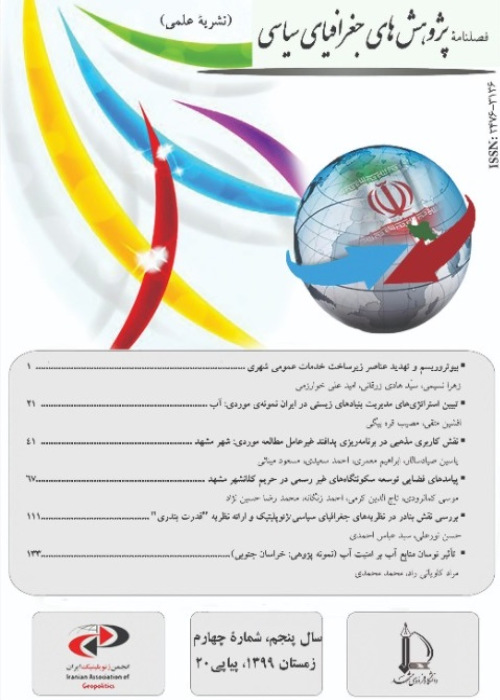Comparative Investigation of Political Management Indexes of National Space in Different Theories
Author(s):
Article Type:
Research/Original Article (دارای رتبه معتبر)
Abstract:
Introduction
The political management of space is the study of the methods of administration, control, observation and track in geographic space. The political administration of geographic space in different scales is intended to realize the goals from the strategic point of view, considering the physical, demographic and economic limitations. The political management of the space has been focused in this paper at the national level. The state is the most important political organization representing the people with the broadest goals and duties, and it is responsible for the accurate performance of national policies. In fact, the state is formed to serve the people and administrate the space; it is responsible for supplying the needs of people. Thus, the high performance of the state in all sections is considered and has been focused in all political theories. The duties and principles of the political management of space at the national level have brought theoretical and practical achievements, and different theories are formed in this relation as such.
The political management of space at the national level has both fixed and variable patterns. In the fixed pattern, the states' fundamental goals include independency, territorial integrity, the optimal political management of the state, foreign policy, national interests, the state and citizens identity; the increase in the national power; state security, the role of observation, the political management of space, the creation of state communicational network, organization, planning, development, the establishment of geographic and social justice, the optimal management of the environment, and the creation of public welfare that are common among different states. In the variable pattern, the political management of the space, dependent on the state political system, different patterns such as centralized, federal and etc. are effective in the state administration. Nine factors are effective in the political management of the space, including political system and decision making organs, dominant political thought and ideology, social, economic, administrative and cultural systems, geographic and geopolitical characteristics, and the international system. Regarding the above factors, different patterns of the political management of space are formed in different states within different periods.
The research is intended to investigate and compare the indexes and duties of the political management of national space from the view point of different theories to propose a new model. Most of the humanities majors have focused on issues such as how to construct a state, manage it optimally, and survive it in a global anarchic situation. In spite of scientific developments and the propose of new definitions of indexes and common patterns to manage the state optimally and development of the state, there are different patterns of governing. But the states share the same interests in this relation. Although many of the goals are common among the states, some of them are prioritized by the states and are seen as vital goals, while some of them are neglected due to the state's situations.
Methodology
The research method is descriptive-analytic and the indexes and the functional duties of political system are framed in six main indexes. These indexes include vital, political, economic, cultural, social, and geographic goals. Each of these main indexes has some subsets; therefore, 41 indexes are proposed in a model called circular model. Although the states have different goals and duties, all of them can be placed and developed in this model. The indexes are extracted after considering and criticizing different theories of political management of the national and functional space of the state.
Conclusion
The circular model proposes the priorities, strategies, and goals of the political management of state. In the first circle, vital goals are placed, which are characterized considering the current and perpetual priorities and the needs of the society. Then, the circles from (a) to (∞) are depicted based on the priorities. To consider s systematic point of view regarding the priorities, being radial is another characteristic of the model which can cover all the priorities and goals of the state and society, because priorities would be different and cover all the facets. The goals and priorities located in inner circles are more important than others. Priorities of place can be changed due to the time and place requirements, and they are relocated from center to infinity or infinity to the center. The level of success for the state depends on realizing all the fundamental goals optimally. In fact, the success of each state shows its power and development.Keywords:
Language:
Persian
Published:
Research Political Geography, Volume:2 Issue: 3, 2017
Pages:
1 to 29
magiran.com/p1941235
دانلود و مطالعه متن این مقاله با یکی از روشهای زیر امکان پذیر است:
اشتراک شخصی
با عضویت و پرداخت آنلاین حق اشتراک یکساله به مبلغ 1,390,000ريال میتوانید 70 عنوان مطلب دانلود کنید!
اشتراک سازمانی
به کتابخانه دانشگاه یا محل کار خود پیشنهاد کنید تا اشتراک سازمانی این پایگاه را برای دسترسی نامحدود همه کاربران به متن مطالب تهیه نمایند!
توجه!
- حق عضویت دریافتی صرف حمایت از نشریات عضو و نگهداری، تکمیل و توسعه مگیران میشود.
- پرداخت حق اشتراک و دانلود مقالات اجازه بازنشر آن در سایر رسانههای چاپی و دیجیتال را به کاربر نمیدهد.
In order to view content subscription is required
Personal subscription
Subscribe magiran.com for 70 € euros via PayPal and download 70 articles during a year.
Organization subscription
Please contact us to subscribe your university or library for unlimited access!


